Spanish Bluebells ( Hyacinthoides hispanica ) are a very popular choice for a spring-flowering bulb. The main reason is that they are easy to grow, even for time challenged or lazy gardeners... they are rarely affected by pests and diseases, and also deer and rodents don't enjoy their taste. Their pendulous flowers appear in Spring , rising above deep green clumps of shiny foliage, so they add charm to many garden spots. They are also happy in pots, and can be brought indoors for short periods. They are available in different shades of blue, and also in pink and white colours. There are other species of Bluebells with similar characteristics as these.
Bluebells are frost-tolerant to -20 degrees centigrade, and will be happiest in a temperate to cooler climate. Keep the soil moist where they are planted, and give them a position with semi-shade , or dappled sunlight under trees. I took these photos in a Sydney suburban garden. Some of these are growing in a lawn, so care has to be taken not to cut them off with the mower !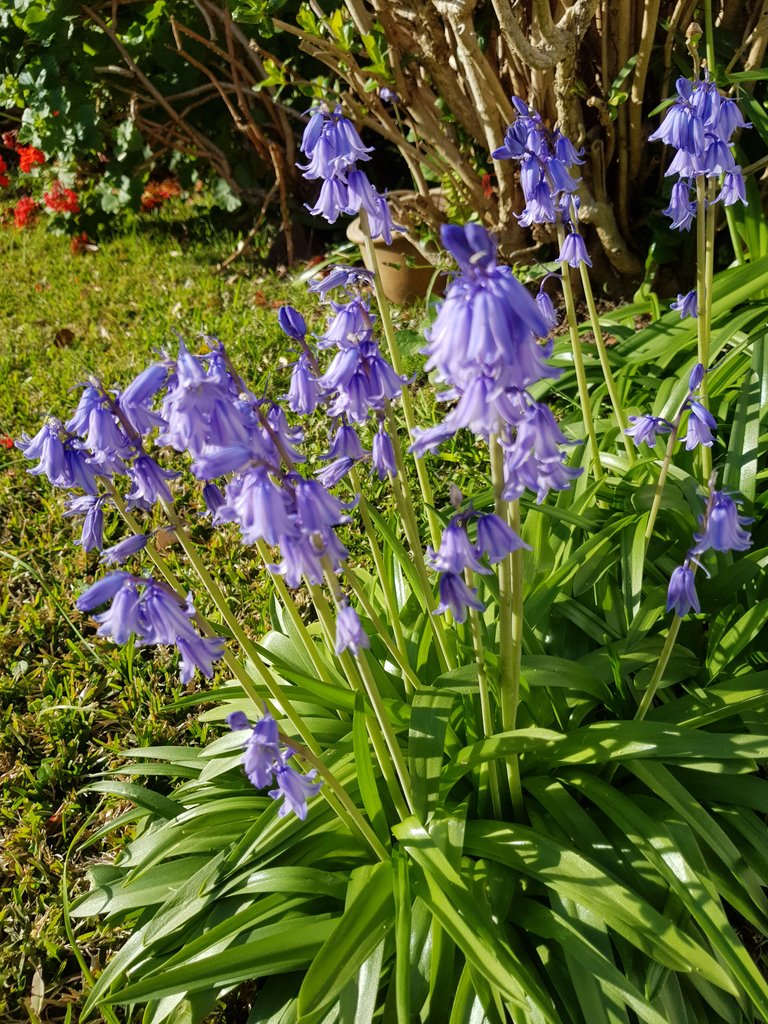
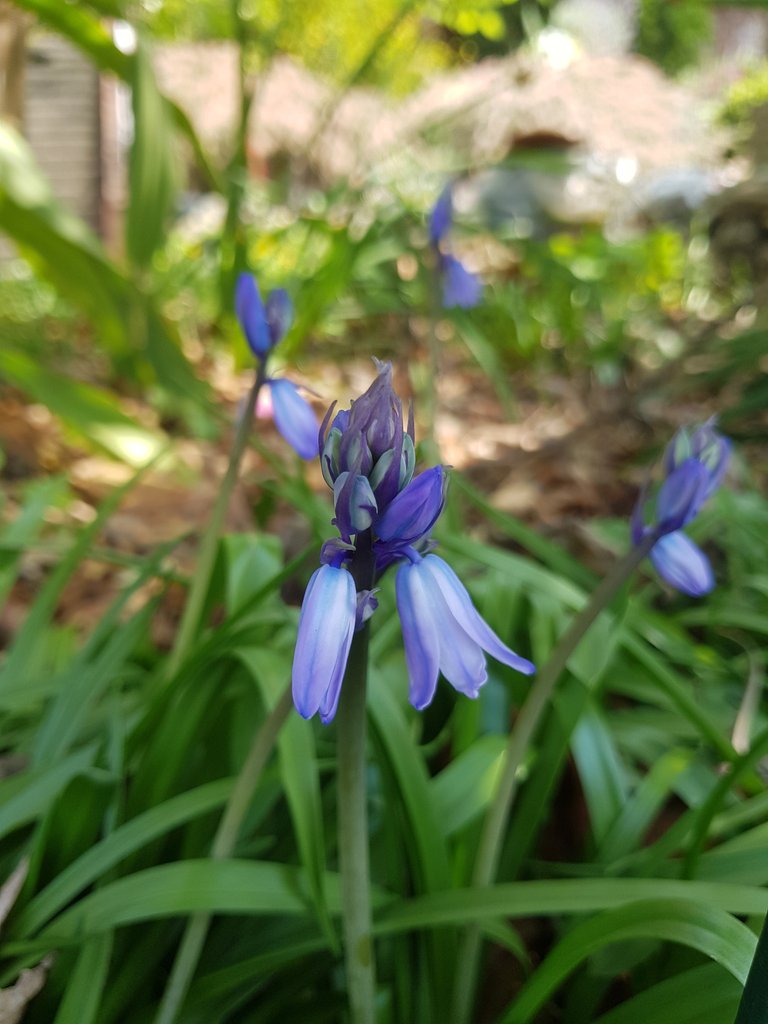
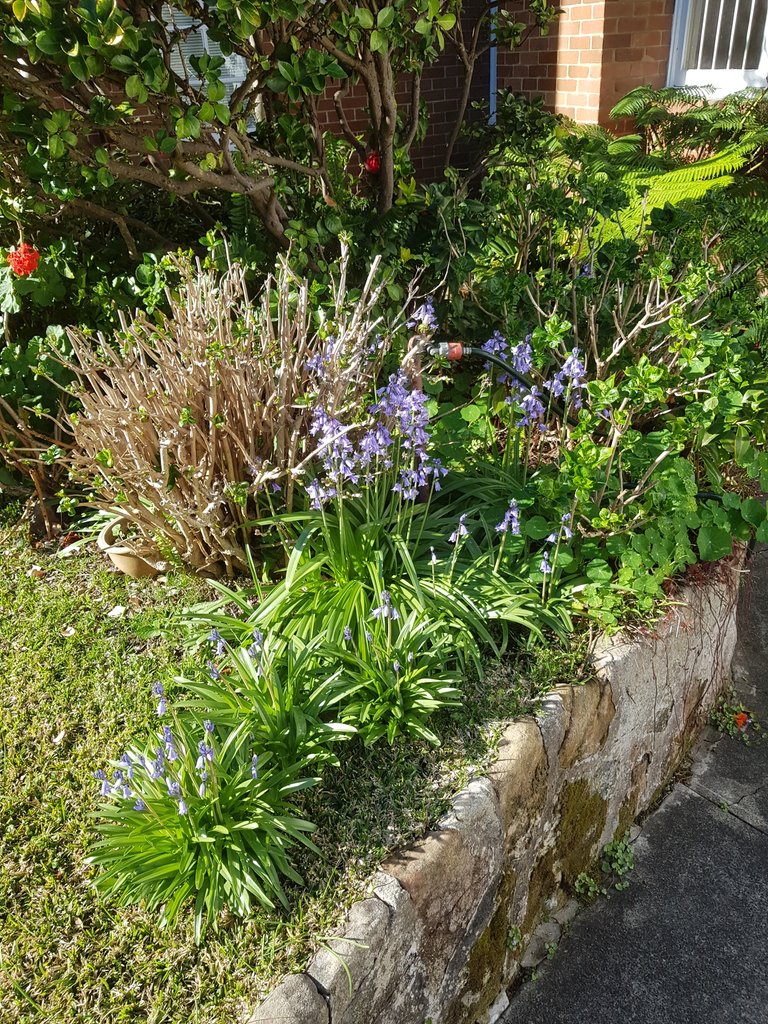
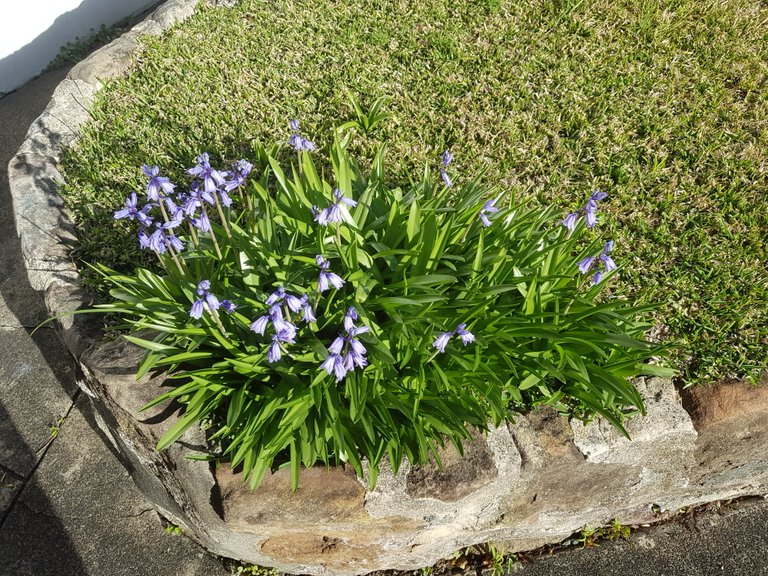
Also known as Wood Hyacinths, Spanish Bluebellls (Hyacinthoides hispanica) are charming additions to the spring garden. The pale blue, dangling bells complement yellow daffodils, red tulips, white lily-of-the-valley, and many other spring flowers.
Spanish bluebells are bulbous perennials native to Spain, Portugal and northwest Africa. Each bulb produces a clump of 2-6 strap-shaped leaves and a flower stem with 12-15 hanging, bell-shaped flowers. The plants are 12-18" tall. The bulbs are inexpensive, readily available, and easy to grow, so if you are new to bulb gardening, they are great plants to try.
Hardy in zones 3-8, Spanish bluebells will grow in full sun to part shade, and are not fussy about their soil requirements. They are good naturalizes, spreading both through bulb offsets and seeds. Here in New England, they will spread discreetly but steadily, making a cheerful community. Like other spring bulbs, they should be planted in the fall, and will bloom in early April to early May. The leaves will disappear as the plants go dormant for the summer.
http://www.enchantedgardensdesign.com/blog/2016/4/4/spanish-bluebells
Fav. comment Award ! Thanks for the great Pics.
Spanish bluebells are an easy-care spring-blooming bulb that does best in full sun (at least six hours of direct sun per day) or part shade. While they tolerate all-day shade, they don't tend to bloom as well. As the plants go dormant in early summer after they've leafed out, they're ideal for growing beneath deciduous trees like oaks and maples.
The best time to plant Spanish bluebells, like most other spring-blooming bulbs, is in early fall as soil temperatures begin to cool. These plants are not fussy about soil type, but they bloom best and spread fastest in a soil that's moist, well-drained, and rich in organic matter. Avoid soil that has a high clay content; in soggy soil they have a tendency to rot out and die over the summer.
https://www.bhg.com/gardening/plant-dictionary/bulb/spanish-bluebell/
Fav. comment Award !! Well done on your choice of Pics.
Spanish Bluebells (properly, Hyacinthoides hispanica) are best known for their pendent clusters of blue flowers, but there are also charming pink and white varieties available. Massed in a woodland or sprinkled through the perennial border, they mount a colorful and long-lasting display that will be repeated for many years to come. Not labeled. 25 bulbs cover 3 sq ft.
This small genus of spring-blooming bulbs from Europe and Asia is one of the most versatile and valuable because of its extraordinary willingness to prosper and bloom in sun to deep shade (some shade is required for satisfactory performances in the South). They thrive in a wide range of climates and well-drained soils, although a site with ample moisture early in the growing season is the key to abundant flowers. They will spread discreetly but steadily, making a cheerful community, then disappear by midsummer. Because Hyacinthoides are later bloomers, they are useful in the transition from early-spring bulbs to the first June perennials.
Find out from= https://www.whiteflowerfarm.com/310531-product.html
Excellent Pics, thanks !
Botanists now want us to call Spanish bluebells Hyacinthoides hispanica. But older names persist, including Scilla hispanica; they were also formerly placed in the Endymion genus. The package that you buy at the store may well be labeled Scilla campanulata -- yet another botanical name for the plant.
The scientific names of plants are supposed to make our lives easier as gardeners, giving precision where there would otherwise be chaos. Usually, they live up to their mission statement. Sadly, sometimes botanists have trouble figuring out what botanical name they wish to give a plant. The result is that older literature is littered with the rejected names, as the new name struggles to gain preeminence.
Plant height (and the number of flowers per stalk) will vary according to factors such as the size of the bulb. During the first year that you grow these plants in your yard, the tallest plant may reach 16 inches, while the shortest may stand around 7 inches high (these heights include the floral stalk). Size may diminish in subsequent years. The foliage is basal and sword-shaped, forming a clump.
Source: https://www.thespruce.com/spanish-bluebells-late-blooming-spring-bulb-2132115
Lovely Pics, thanks.
Hyacinthoides hispanica
Also known as the Wood Hyacinth or Spanish Bluebells, this invaluable 17th century heirloom has graced European woodlands for centuries. It has strappy, linear foliage and strong, 12" to 15", rigid, upright stems with 15 to 20 pendant, bell-shaped flowers in the most beautiful shade of shimmering blue-violet with darker, marine-blue midveins. Previously classified as Scilla campanulata Excelsior
Previously classified as Scilla campanulata Excelsior, it thrives in most soil and sunlight conditions, although it prefers a bit of light shade or dappled sunlight. Widely used in both naturalized woodland settings and display gardens, this deer- and rodent-resistant naturalizer matures over the years, becoming increasingly more substantial and prolific.


When it’s really happy where planted, it can naturalize by both bulb offsets (baby bulbs on the sides of the mother bulb you’ve planted) and self-sowing seed. Really mature clumps of Excelsior can stretch taller, up to around 20". They impart a special look and feel to woodlands: kind of like a magical cross between a Wizard of Oz garden and a midsummer’s night dream.
You’ll need about nine bulbs per square foot. (Square footage is determined multiplying the planting site’s length times its width.) In woodland settings, you can also scatter-plant the bulbs about for a more natural look.
Bulb size: 8 cm/up. Full to partial sunlight. Bloom time in horticultural zone 5: May. Plant 4" deep and 4" apart. Horticultural zones 3-8. Height: 12" to 15".

References12345
Silly Sausage Award !! Excellent Pics, thanks.
THank you so much!
@ctrl-alt-nwo,
I like the last photography most! They looks beautiful and like you said good for lazy gardeners like I do! I think I have some memories about this flower/plant at hill country of mine! Sometimes it might me a similar type of plant with that type of flower! Probably I took photography of them, due to attractive look of it! Nice photography and great description! Really appreciate your effort!
Cheers~
Shared on twitter promoting good quality content on #Steemit.
Stephen
#Promo-Steem #steemtalent #JoinSteemit #Steemit
Source
Spam is discouraged by the community, including comment spam.
More Information:
The Art of Commenting
Comment Classifications
Thanks again for the support !
It is a gorgeous flowering plant @ctrl-alt-nwo and also looks good to be put in any garden.
Interesting flowers. I liked the color combinations of bluebells and green leaves. It looks very beautiful.
These are natural and stunning Bluebells wonderful to see them in your post today :D
Oh! I miss these purple bluebells! How I wish I could grow a carpet of purple bluebells in my garden! I used to walk in a forest full of bluebells long time ago!
This brings back very beautiful memory.
Posted using Partiko iOS
These flowers are always pleasing to the eye. The variety of their colors and shapes is huge. Very interesting pictures are obtained with macro photography. Flowers are very textured inside.
Hyacinthoides hispanica (Miller) Rothmaler, Repert. Spec. Nov. Regni Veg. 53: 14. 1944.
Spanish bluebell
Scilla hispanica Miller, Gard. Dict. ed. 8, Scilla no. 8. 1768; Endymion hispanicus (Miller) Chouard; Hyacinthoides non-scripta (Linnaeus) Chouard subsp. hispanica (Miller) Kerguélen
Plants 20–40 cm; bulb 1–2 mm diam. Leaves 4–8; blade linear-lanceolate to lanceolate, 20–50 cm × 10–35 mm. Racemes 6–8-flowered, not 1-sided, apex not drooping. Flowers erect in bud, at least distal ones remaining so, not fragrant; perianth campanulate; tepals spreading, not reflexed distally, blue, oblong-lanceolate, 1.5–2 cm; stamens equal, inserted below middle of perianth; anthers blue; pedicel 4–10 mm, ± equaling perianth. 2n = 16, 24.
Flowering late spring. Escaped from gardens; 0--1000 m; introduced; Va.; sw Europe, nw North Africa.
source
This is one of my favorite flowers i grow it as well in my backyard, but they not looking so nice as yours
Hyacinthoides hispanica (syn. Endymion hispanicus or Scilla hispanica), the Spanish bluebell, is a spring-flowering bulbous perennial native to the Iberian Peninsula. It is one of around 11 species in the genus Hyacinthoides, others including the common bluebell (Hyacinthoides non-scripta) in northwestern Europe, and the Italian bluebell (Hyacinthoides italica) further east in the Mediterranean region
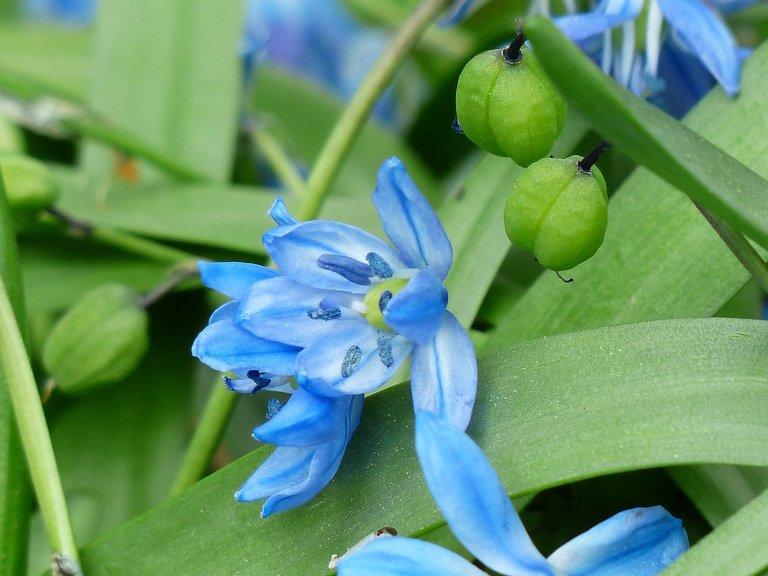
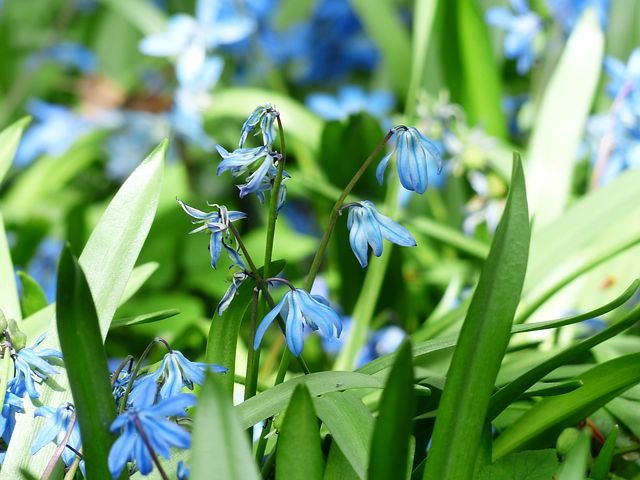
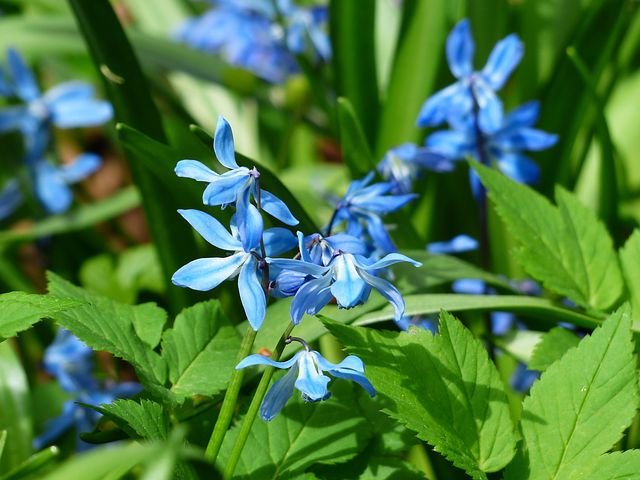
Source
Source
Source
It is distinguished from the common bluebell by its paler and larger blue flowers, which are less pendulous and not all drooping to one side like the common bluebell; plus a more erect flower stem (raceme), broader leaves, blue anthers (where the common bluebell has creamy-white ones) and little or no scent compared to the strong fragrant scent of the northern species. Like Hyacinthoides non-scripta, both pink- and white-flowered forms occur. Source
magoo-2 found a series of multi accounts of a same owner is following your articles to cheat your generous rewards.
magoo-2 found these accounts are suspicious & can be multi accounts of a single owner. Conclusion is based on last 30 days transactions:
@alves
@devid1996
@mhyeasin
@sadikulaziz
@msena
@kilee
@ripon1
@googlefighter
@melianasagita
@ashasikder
@hichako
magoo-2
Check our latest multi comment spam update report
very beautiful plants i love lavander color 😍😍
That color red flowers also at the back looks cool..
@ctrl-alt-nwo, Really great to hear how you called these flowers as Spring Flower Bulbs and for sure, these flowers are beautiful and colourful and these flowers can spread the beautiful essence in lives. And many people tend to use different colorful flowers in Festive season and flowers makes the festive season an colorful season and also hold the welcoming essence.
Good to know and Informative to know that Bluebells are rarely affected by pests or diseases. In my opinion when plants are naturally protected then for sure it's an amazing aspect and may be people will choose this plant to grow in their garden to make the environment more magical.
One more informative point to know that these plant prefer the cooler Temperature and when we see lawns no matter where most of the times we see some breathtaking plants which attracts everyone and also spreads the beautify effect in the Environment.
Wishing you an great day and stay blessed. 🙂
Congratulations @ctrl-alt-nwo!
Your post was mentioned in the Steemit Hit Parade in the following category:
Hyacinthoides hispanica or the 'Spanish Bluebell' as it is commonly known is the ultimate in low-maintenance perennial gardening. It pops up its fresh green head, rewards neglect with a fountain of blue, violet, pink or white flowers and then enters its enchanted sleep – until next year, when it repeats the whole performance yet again.
As you’d expect, all the colours are a perfect match, making it well worth mass-planting them for a symphony of soft colours in spring.
Alternatively, try interspersing Hyacinthoides hispanica (Spanish Bluebells) with contrasting yellow flowers for a tapestry of vibrant colour. Wonderful in woodland gardens or informal cottage gardens, they’re just as effective when surrounded by other blooms in a mixed border.
source
Bluebell flowers are dainty bulbous perennials that provide a profusion of color ranging from deep purple to pinks, whites and blues from April to mid May. Although some confusion may arrive from various English and Latin names, most bluebells are also known as wood hyacinths.England and have been gracing gardens and wooded areas with their beautiful bluish-purple flowers since the early 1500’s. These spring delights reach heights of 12 inches and can be planted in the fall for spring bloom. The flowers are fragrant and make a wonderful addition to any cut bouquet. An interesting feature of English bluebell is that the flowers are all on the same side of the stalk, and when gravity kicks in the stalk bends in a dainty curve.
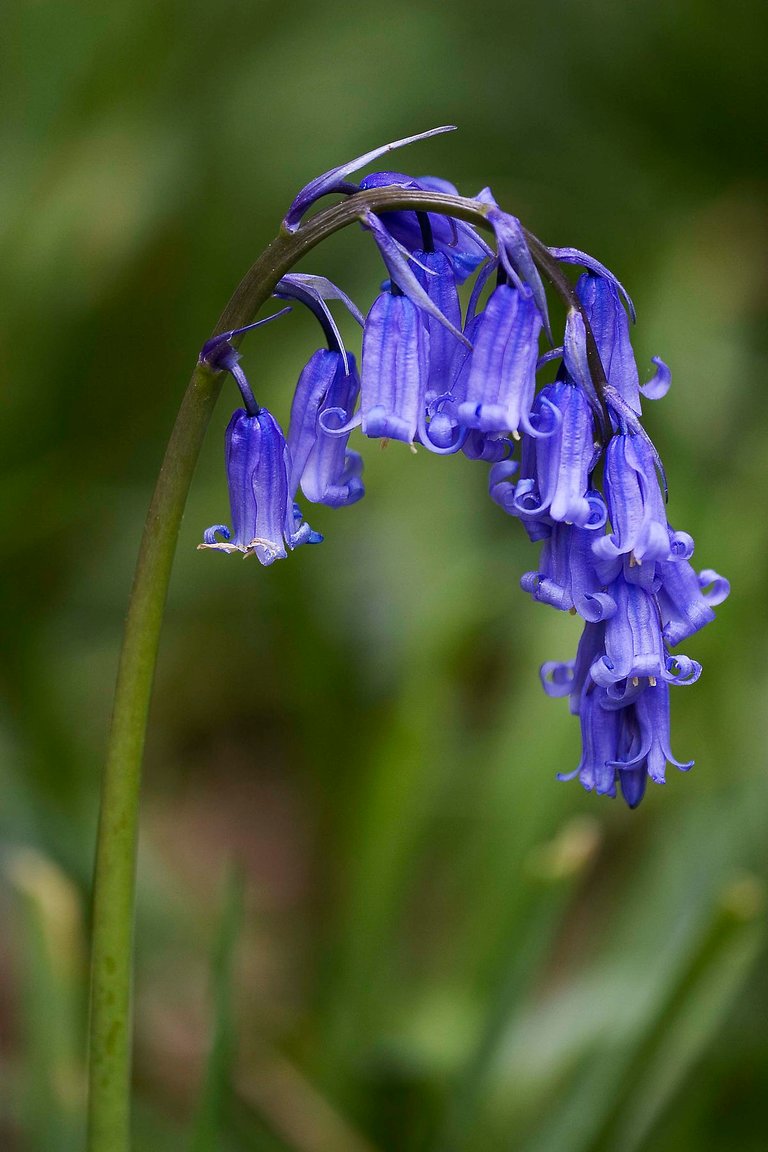.jpg)
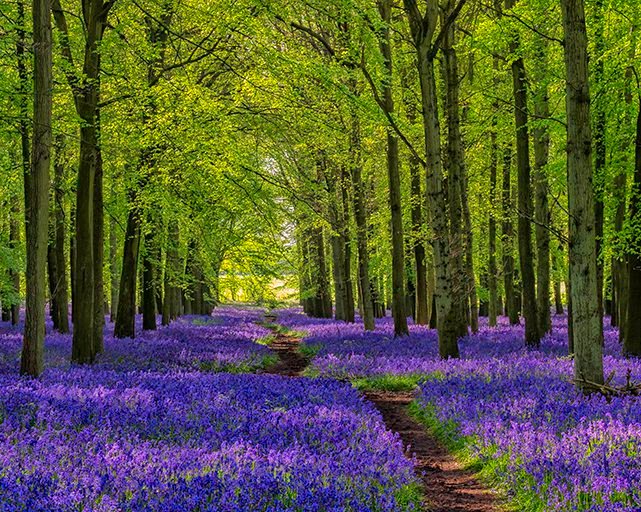
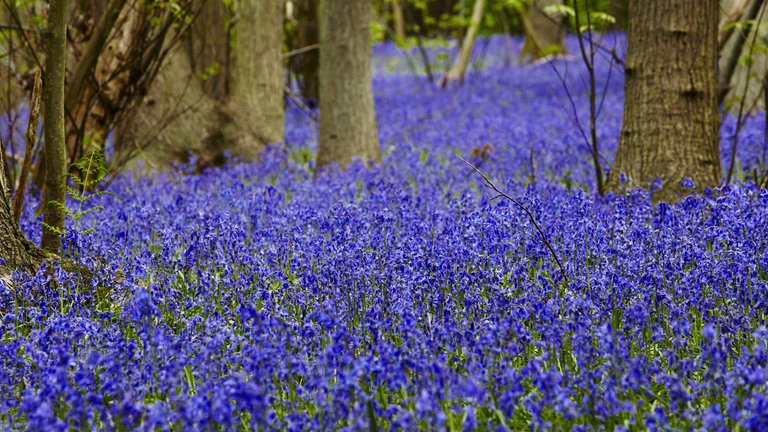
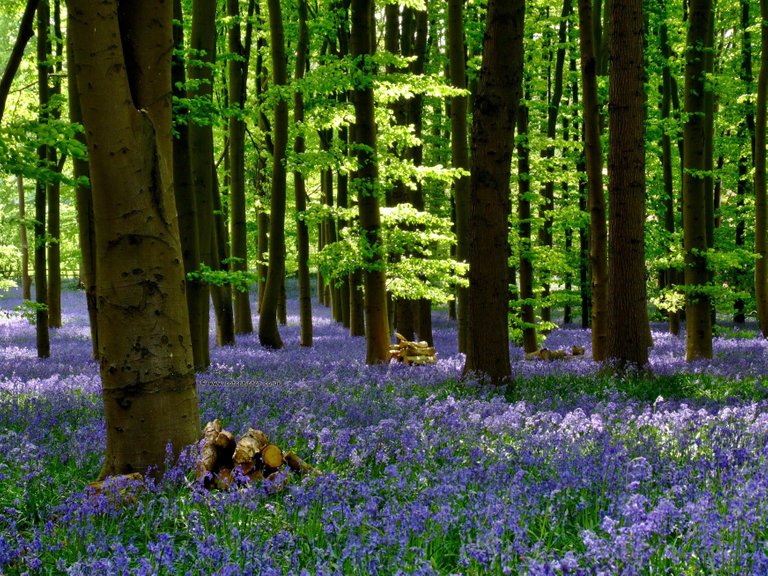
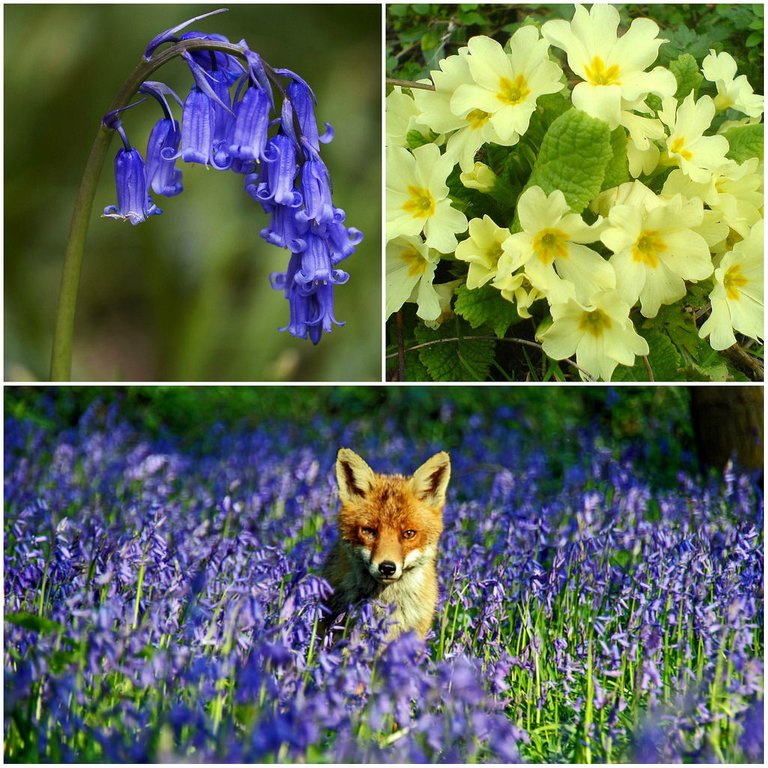
The care of wood hyacinth plants requires minimal energy. These easy-to-please bulbs naturalize rapidly and prefer well-drained soil with a high organic content.Plant bluebell bulbs after the heat of summer has passed or in early fall. Several bulbs can be placed in the same 2-inch deep hole.
[Source]https://www.gardeningknowhow.com/ornamental/bulbs/bluebell/grow-wood-hyacinth-bluebells.htm
Spanish Bluebell (Hyacinthoides hispanica) is a very beautiful annual plant! Each bulb produced attractive flowers, nodded, and bell shaped hanging from a sturdy round flower stalk, on top of a shiny rope-shaped leaf clump.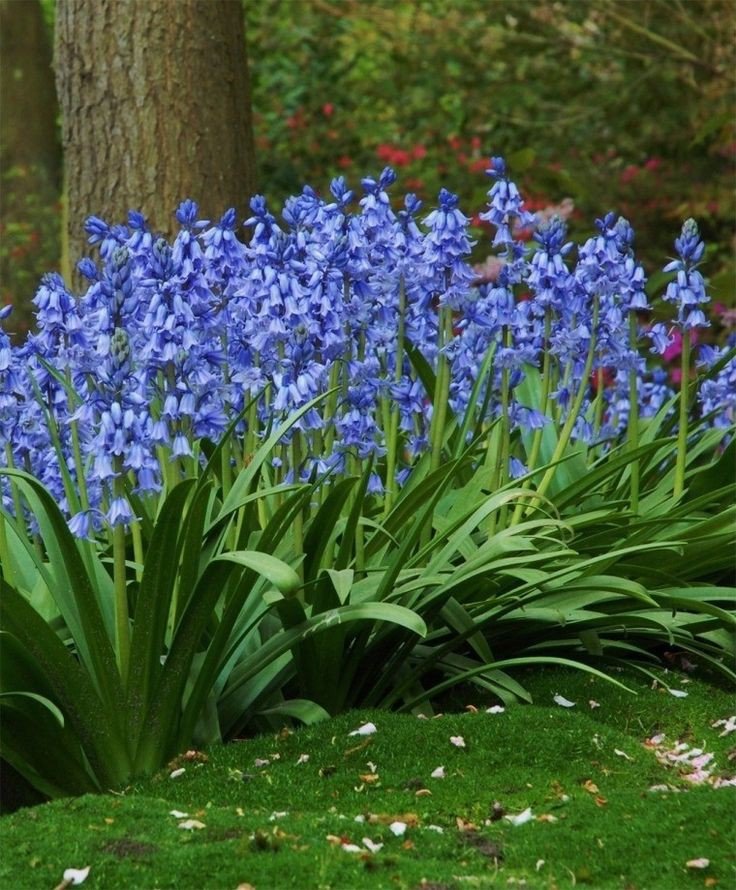
Spain Bluebell is a reliable plant for landscapes, where it will happily double under conditions of optimal growth. Depending on cultivars, Spanish Bluebell is in shades of purple blue, lavender blue, pink or white. This usually forms clots up to 12-18 in height and width (30-45 cm).
This plant is easy to grow and is rarely affected by pests or diseases. This charming lover gives color and contrast to the forest park, bed boundaries, stone gardens and naturalized areas. In addition, it can be planted in a pot or container, and blends beautifully with other flowering bulbs.
Source
Hyacinthoides hispanica, commonly called Spanish bluebell or wood hyacinth, is a bulbous perennial that is native to Spain, Portugal and northwest Africa. Each bulb produces a clump of 2-6 strap-shaped leaves from which rises a rigid flower stem typically containing up to 12-15 hanging, bell-shaped, bluish-lavender flowers held in an upright raceme. Flower stems rise to as much as 18” tall. Flowers typically bloom April to early May.
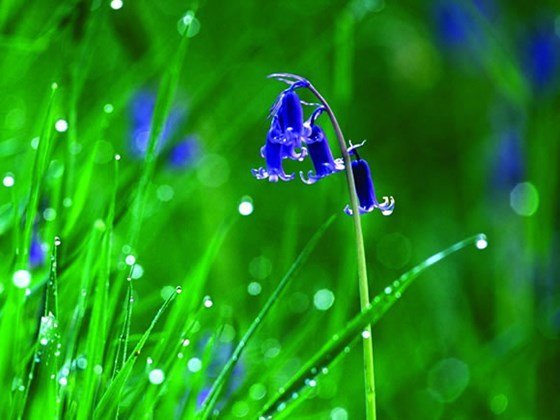
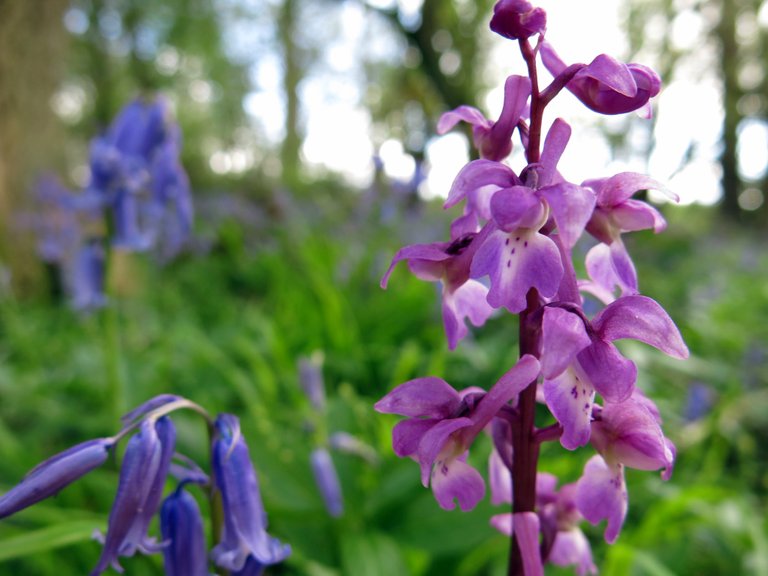
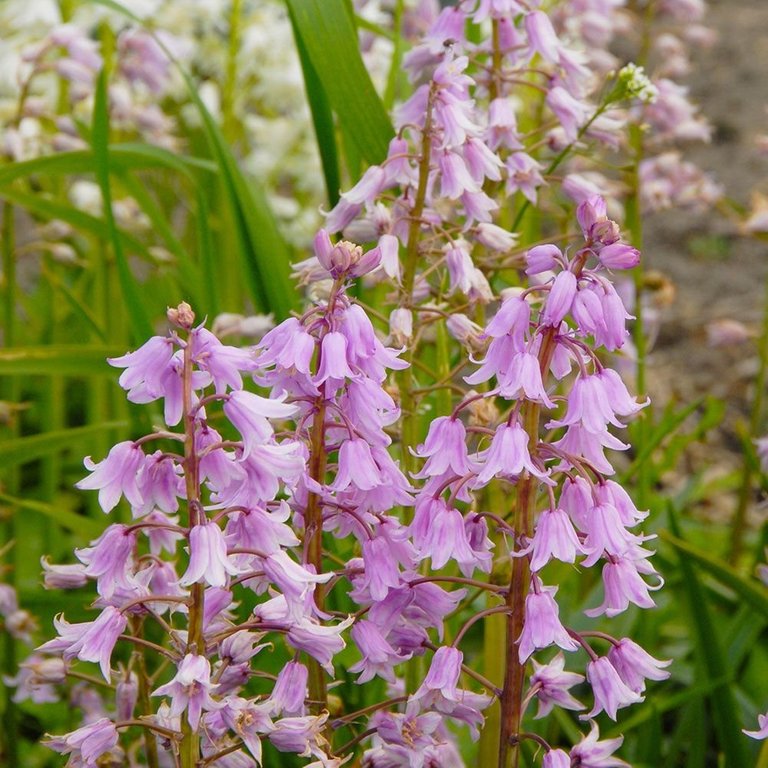
image source
image source
image source
Easily grown in average, medium moisture, well-drained soil in full sun to part shade. Prefers sandy well-drained soils. Avoid unamended clay soils. Tolerates shady conditions. Perhaps best in sun-dappled part shade. Plant bulbs about 3-4” deep and 4-6” apart in the fall. Naturalizes well by both bulb offsets and self-seeding in optimum growing conditions. Plants go dormant by early summer. Plants of this species (Spanish bluebells) will hybridize with plants of Hyancinthoides non-scripta (English bluebells) if planted near each other, resulting in different forms appearing through self-seeding.
content source
They are looking great i just love Bluebells
Mui buen flowercitas :) this bluebells are perfect fit for corners as I see on your last photos😙.
Spanish bluebells is a bulbous perennial native to Spain, Portugal and northwest Africa. It is a showy spring-flowering herbaceous plant with strap-shaped leaves and nodding, lavender, bell-shaped flowers on erect stalks that stand up to 18 in. high.
Plants become dormant by early summer. Previously known as Scilla campanulata and Scilla hispanica. It is currently documented to occur in the wild in Delaware, Virginia and North Carolina and may be underreported. Spanish bluebells is known to naturalize and spread, a feature appreciated and used by the horticulture industry as a marketing tool.
It poses a threat to native spring-blooming wildflower species already being heavily impacted by other non-native invasives like fig buttercup, garlic mustard, and nodding star-of-Bethlehem. For these reasons, it is a plant to keep an eye on and be prepared to remove if it is found invading natural habitats.
source
hispanica 'Excelsior' - this is perhaps the 'King' of hyacinthoides as the size of the blossoms and vigor are excelled by none; rich deep blue flowers form luscious naturalized woodland meadows and rivers; Heirloom; 1906; 10"-12".
One of the most adaptable bulbs; very shade tolerant but also performs beautifully in our full sun flower borders; lovely bell-shaped flowers on 8"-12" stems; excellent, cut flowers and naturalizers; Heirloom; whz 4-10. (8/10cm bulbs)
source
Bluebell Hyacinthoides non-scripta
Bluebells spend most of the year as bulbs underground in ancient woodlands, only emerging to flower and leaf from April onwards. This early spring flowering allows them to make the most of the sunlight that is still able to make it to their forest floor habitat and attracts the attention of plenty of pollinating insects. Millions of bulbs may exist in one bluebell wood, causing the blue carpets we so keenly associate with spring, and new plants are sometimes able to split off from these bulbs and grow as clones.
Behaviour
Source
Beautiful modest flower. The plant has many names, it is hyacintoides, endymion, hyacintoid, Spanish scilla (scilla). Spanish proleska very similar to hyacinth, for which she received another nickname - wild hyacinth. The perennial flower is unpretentious and not exacting, it definitely deserves the attention of gardeners.
Source
Bluebell flowers are flowers that are easily found in the Atlantic region of Spain and continue to rise to islands in the UK. This flower is not only beautiful, but also fragrant. Bluebell has a distinctive scent that may not be available from other flowers. In addition, bluebell flowers also have their own uniqueness. Unlike the other flowers that usually bloom facing the sky, bluebell flowers tend to grow curved so that the petals face down.
Source
Even so, when it blooms perfectly, bluebell flowers can also grow to face the sky and no longer hang. When it's like this, we can see the petals more clearly as seen in the photo above.
Source
magoo-2 found a series of multi accounts of a same owner is following your articles to cheat your generous rewards.
magoo-2 found these accounts are suspicious & can be multi accounts of a single owner. Conclusion is based on last 1 year transactions:
@faizazohaib
@faraz33
@zohaib336
magoo-2
Check our latest multi comment spam update report
Today the flowers that you shared among us are small but it is so beautiful that can not be imagined that all of your photography has been beautiful . your second picture is more beautiful. I love your followers very much. Thank you so much For sharing photos of flowers
I liked this flower very much. I saw it growing in our fields. A perennial bulbous ephemeroid plant 25-30 cm tall. The leaves are narrow, linear, gathered in the rosette. The flowers are blue-purple, pink or white; bell-shaped, with a diameter of up to 1.5 cm, are collected on the top of the peduncle in a racemose inflorescence. It blooms in late May-June.
The plant is light-requiring, but it is able to endure partial shade. Soils like well-fertilized, moderately wet, without stagnant water. Relatively winter-hardy, in conditions of central Russia needs a small shelter.
It belongs to the juvenile plant - once every three years it must be divided and transplanted. Propagated by bulbs and seeds.
Looks impressive in the form of small groups, an excellent cut plant. Thank you for an interesting post.
http://plantsvideoworld.ru/2016/02/01/hyacinthoides-hispanica/
These unfussy members of the lily family are native to Spain and Portugal and we couldn't be happier to have them in gardens here in the States. Pretty, inexpensive, good for cutting, unfussy about light and soil, and able to thrive on neglect, they'll earn their keep in any garden. If you're just getting started with bulb gardening, this is a great place to begin.
https://www.thespruce.com/thmb/3ppROJWFLllINx1-3vpxSKqa9S0=/450x0/filters:no_upscale():max_bytes(150000):strip_icc()/blue-spanish-bluebell-big-56a584d35f9b58b7d0dd419c.jpg
For gardeners who really know their way around a trowel, you'll like these, too. First-rate naturalizers, Spanish bluebells reproduce by developing small offsets (baby bulbs) on the sides of the mother bulbs. They also produce seeds, allowing them, over time, to fill in and create ever larger patches of spring brilliance.
Great plants for difficult garden sites, just think how Spanish bluebells will respond to more hospitable conditions.
source
magoo-2 found a series of multi accounts of a same owner is following your articles to cheat your generous rewards.
magoo-2 found these accounts are suspicious & can be multi accounts of a single owner. Conclusion is based on last 30 days transactions:
@saikr
@christian.danny
@aaeesha
@sarah.taylor
magoo-2
Check our latest multi comment spam update report
Source
Bluebell flowers are flowers that are easily found in the Atlantic region of Spain and continue to rise to islands in the UK. This flower is not only beautiful, but also fragrant. Bluebell has a distinctive scent that may not be available from other flowers. In addition, bluebell flowers also have their own uniqueness. Unlike the other flowers that usually bloom facing the sky, bluebell flowers tend to grow curved so that the petals face down.
Source
Bluebell flowers grow in crowds that can expand. Look at the photo of the bluebell flower above. See how the flower fields bluebell beautify the path that divides it.
Source
This flower usually grows low around the base of the trees in large quantities so that it looks like a rug. Common British people call this natural phenomenon the name bluebell woods.
Source
As the name means blue bells, the bluebell flower grows hanging on its branches with the petals facing the ground. This uniqueness is what distinguishes it from many other flowers.
Source
Even so, when it blooms perfectly, bluebell flowers can also grow to face the sky and no longer hang. When it's like this, we can see the petals more clearly as seen in the photo above.
Reference
magoo-2 found a series of multi accounts of a same owner is following your articles to cheat your generous rewards.
magoo-2 found these accounts are suspicious & can be multi accounts of a single owner. Conclusion is based on last 30 days transactions:
@seha76
@faisalrizal2018
@roman-sabil
magoo-2
Check our latest multi comment spam update report
Amazing flowers sir thanks for your research sir as usual you have brought the best of the best.
Deep violet-blue, darker and larger than most varieties of Hyacinthoides hispanica. Heirloom, 1906.
Formerly included with Scilla, Hyacinthoides is a small genus of spring-blooming bulbs from Europe and Asia. Its members are some of the most versatile and valuable because of their extraordinary willingness to prosper and bloom in sun to shade (some shade is required for satisfactory performances in the South).
They thrive in a wide range of climates and well-drained soils, although a site with ample moisture early in the growing season is the key to abundant flowers. They will spread discreetly but steadily, making a cheerful community, then disappear by midsummer. Because Hyacinthoides are later bloomers, they are useful in the transition from early-spring bulbs to the first June perennials.
source
Appearance
Hyacinthoides hispanica is a perennial herb that can grow from 7.9 to 15.7 in. (20-40 cm) tall.
Foliage
Leaves are linear to lanceolate, strap-shaped, 7.9 to 19.7 in. (20-50 cm) x 0.4 to 1.4 in. (10-35 mm). Each plant usually has only 4 to 8 leaves.
Flowers
Each raceme has 6 to 8 flowers. Flowers are bell-shaped, erect in bud but hang when in bloom, not fragrant, tepals are spreading, blue to purple in color, oblong to lanceolate, 0.6 to 0.8 in. (1.5 to 2 cm).
Fruit
Plant can reproduce by bulb or by self-seeding. Bulbs are 0.04 to 0.08 in. (1-2 mm) in diameter.
Ecological Threat
Hyacinthoides hispanica can be found in woodland edges, and in other disturbed areas. It is native to Spain, Portugal and Northwest Africa.
source
Wow so very beautiful garden, thanks for sharing.really nice for lovely Bluebells and flowers.....
Resteem
Hyacinthoides hispanica (Mill.) Rothm. (syn.: Endymion hispanicus (Mill.) Chouard, Scilla hispanica Mill., S. non-scripta (L.) Hoffmanns. et Link subsp. hispanica (Mill.) Ietswaart, Hyacinthoides non-scripta subsp. \
hispanica (Mill.) Kerguélen) (SW-Eur., N-Afr.) – A locally naturalized garden escape. Surely over-recorded for the often exceedingly similar H. xmassartiana (see there). As a result of introgression Hyacinthoides hispanica may possibly disappear in favor of the latter in its Belgian locations.
Many diacritic features for their distinction (width of leaves, length of tepals,…) are variable and therefore unreliable. The characters provided in the key appear to be (more or less) unequivocal but are only useful in the field.
The specific status of Hyacinthoides hispanica is still controversial (Grundman & al. 2010). It has been combined under Hyacinthoides non-scripta in the past (see synonyms). Especially the ease with which introgressive hybridization between these two species occurs, suggests a very close relationship. According to Grundman & al. (2010) British (triploid) populations of Hyacinthoides hispanica do not correspond with autochthonous (diploid) material from southwestern Europe.
The exact origin of these vigorous plants and their taxonomic position compared to genuine Hyacinthoides hispanica needs further study.
source
Bluebell flowers are flowers that are easily found in the Atlantic region of Spain and continue to rise to islands in the UK. This flower is not only beautiful, but also fragrant. Bluebell has a distinctive scent that may not be available from other flowers. In addition, bluebell flowers also have their own uniqueness. Unlike the other flowers that usually bloom facing the sky, bluebell flowers tend to grow curved so that the petals face down.
Source
Even so, when it blooms perfectly, bluebell flowers can also grow to face the sky and no longer hang. When it's like this, we can see the petals more clearly as seen in the photo above.
Source
Bluebell Hyacinthoides non-scripta
Bluebells spend most of the year as bulbs underground in ancient woodlands, only emerging to flower and leaf from April onwards. This early spring flowering allows them to make the most of the sunlight that is still able to make it to their forest floor habitat and attracts the attention of plenty of pollinating insects. Millions of bulbs may exist in one bluebell wood, causing the blue carpets we so keenly associate with spring, and new plants are sometimes able to split off from these bulbs and grow as clones.
Behaviour
Source